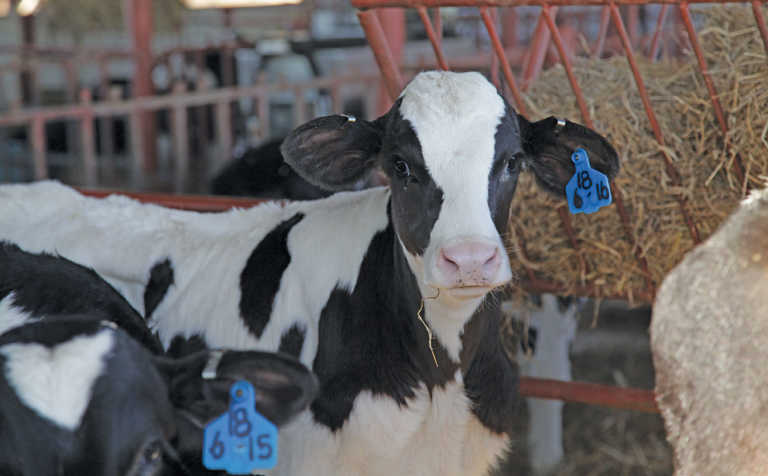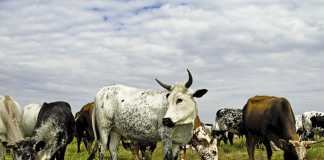
Photo: Gerhard Uys
Many dairy producers struggle with calf mortality and slow growth. Dr Chris van Dijk, veterinarian and CEO of the Milk Producers’ Organisation, (MPO) and Kenneth Botha, feed specialist and technical director at Barnlab Feed, stress that good calf cage hygiene and a colostrum programme are essential for addressing this problem and raising a healthy herd.
Cryptosporidium Parvum
Speaking at an MPO training day in Lichtenburg, North West, Van Dijk explained that incorrect hygiene and management practices were the main cause of Cryptosporidium parvum infection.
READ Signs of a healthy dairy cow
The tiny, two- to six-micron coccidian protozoa organism infects mainly the small intestine and leads to diarrhoea. It damages the gut villi, leading to poor absorption of nutrients.
“This is often lethal in newborn calves, or puts their growth at risk, which in turn affects their eventual production.”
C. parvum is particularly difficult to control as it forms oocysts with a protective outer layer. It is resistant to disinfection, but it can be destroyed by ozone, chlorine dioxide or desiccation.
“In a milking parlour, there are always liquids, and calves with a C. parvum infection are also susceptible to Escherichia coli, salmonella, and the coronavirus or rotavirus. Some farmers have lost many calves to it.”
Cryptosporidium is prevalent throughout South Africa; a sign is chronic diarrhoea, especially in young calves. Although mortality may not always be high, morbidity is, and other infections abound as the calves’ immunity levels are low.
Transmission
C. parvum in the gut is passed on via dung, water, milk and food. It then infects new hosts via the faecal-oral route, and can infect humans.
“Once excreted via dung, it can survive in soils for a lengthy period,” says Van Dijk. “It eventually sporulates, which leads to many more organisms being passed into the environment.
“If calves have diarrhoea from five to 15 days of age, one must consider C. parvum as a possible diagnosis. In lambs it may occur between two and 10 days of age and in goats, between five and 21 days of age. Calves usually have lower mortality but show high levels of morbidity and possible infection by other diseases.
“The incubation period is about four days. Clinical signs such as anorexia, refusing to drink milk, and a yellow, putty-like diarrhoea are a sure indication. Post-mortems show lesions, yellow intestinal contents, hyperaemia of intestinal contents and a bloody look to the gut.
It’s important that a veterinarian takes a sample and sends it to a pathologist. This will indicate if the disease may be found in the remainder of the herd.”
There is no specific treatment for C. parvum.
“Supportive care is most likely to succeed,” says Van Dijk. “Electrolytes to replenish sodium, and liquids are essential. Secondary bacterial infections must also be treated. Vaccinating against coronavirus and rotavirus, and boosting the immune system with trace elements and Vitamin A, are also essential.”
Camps, cleanliness, and worker control
Environmental control is often the best way to avoid C. parvum. Rotating calf camps, and leaving them empty during rotation, is essential as calves can be infected within a few hours of being placed in a camp where C. parvum persists.
Sick animals must be kept away from healthy ones. Similarly, animals should not be bought from an auction unless one knows where they come from and what the herd health was prior to sale.
Feeding utensils and buckets must be cleaned, and rats and flies kept under control, as they can transfer the organism.
“People entering calf camps or cages must be controlled, and someone should be assigned to work only with the calves,” says Van Dijk.
“If this isn’t possible, the person working with the cattle must make calves the first task of the day. For this, they must at least disinfect their shoes or wear dedicated footware used only for working with the calves.
“It should also be borne in mind that whoever loads milk may have been on a number of dairy farms during that day and should be kept away from the animals.”
Why colostrum is unbeatable
Adequate intake of colostrum is crucial: a calf needs to take in 10% of its weight within six hours of being born. Colostrum helps build a calf’s immune system, and a cow that has been exposed to C. parvum can pass on antibodies to its calf.
According to Botha, the literature shows that most Holstein genetics give cows the potential to milk 15 000ℓ per lactation. If a cow does not reach this volume, environmental and management factors are to blame.
READ Feeding dairy cows roughage
“To reach her full potential, a cow must be given a head start when she is a calf. To achieve this, a good colostrum programme is a must.”
Depending on the breed, a calf has a birthweight of between 28kg and 52kg. A Holstein calf, for example, must reach a high 60-day weaning weight of about 100kg, which means it has to grow at a rate of about 1kg/day.
“A calf that has a good start will grow faster, reach calving age sooner, and have increased milk production. This isn’t attained by feeding calf pills, but by giving enough colostrum via a colostrum plan, as well as feeding more milk before weaning.”
Botha stresses that milk with colostrum will always beat milk replacers. A Holstein cow’s milk contains 3,2% protein and 3,8% milk fat.
A dry milk replacer with 20% protein and 16% fat will have only 2,5% protein and 2% low fat available once mixed, and hence far lower protein and milk fat content than pasteurised whole fat milk.
“Colostrum has components that milk replacers don’t have; for example, hormones that send a signal to a calf’s brain that tells it to increase daily gains.”
A dairy farmer has to know the quality of the colostrum, otherwise the calf will not receive sufficient immunoglobulin-G, and therefore not build sufficient antibodies to pathogens, or develop a good immune system.
“Ideally, you want a certain level of antibodies per millilitre of colostrum,” says Botha. “So feed 6ℓ of colostrum before a calf is 12 hours old. After 12 hours, the ability to absorb antibodies declines quickly. Give a calf 2ℓ when it is two hours old, then another 2ℓ two hours later and the remainder before it is 12 hours old. If you feed only 4ℓ, the calf may not get enough antibodies.
“With new technology, you can control exactly what’s going on in a herd, and determine when a calf was born, and what and how it was fed.”
If a calf does not consume enough colostrum, a stomach tube can be used.
“The literature shows that if you increase colostrum intake for a calf from 2ℓ to 4ℓ, the survival rate up to second lactation increases by 12%. These cows also produce more milk,” says Botha.
“Imagine if you milk 100 cows and 12 more survive up to the second lactation. With good colostrum, a calf’s insulin and glucose levels increase simultaneously (which is different to normal physiological processes), increasing its chances of survival. Research also indicates that calves do better if fed colostrum up to the age of four days.”
Measuring colostrum using a Brix meter
A Brix meter, which retails for about R800, is used for measuring colostrum. Calibrated to the Brix scale, it correlates to the antibody level in colostrum.
“The first 60 days of a [female]calf’s life have a long-term effect OLDon her,” explains Botha.
“If you neglect her in this period, she’ll never reach her genetic milking potential. Every gram that a cow grows per day is one litre more that she milks in her first lactation. If a calf’s average daily gain is 500g and you can take her to 800g, you’ll get an additional 300ℓ in her first lactation.”
A protein programme
The protein content of milk also affects growth. Most commercial calf pills do not contain the correct amount of protein, or have the correct amino acid profile. Milk protein is more digestible than vegetable or other animal protein sources, says Botha.
Some of the top herds use a 28% protein milk replacer (dry basis, which translates into about 3% wet protein) for 10 days, with a high-protein feed pellet (at least 26% dry matter), then reduce the protein in the pellets to 21% dry matter protein (minimum 18% on an as-is basis).
These herds are fed according to a protein programme based on age and growth rates.
Ideally, the system should start high and decrease over time, as this is what a calf needs, explains Botha.
If a farmer takes the feed requirements of a 50kg calf at two to three weeks, and is looking for an average daily gain of 800g, the calf’s protein need is 27,6%. If she is given only 18% protein, she will grow about 200g on a cold winter’s day.
For a high daily growth rate, milk remains the cheapest form of protein to get, says Botha.
There are good milk replacers on the market, but a farmer should sit down with suppliers, a nutritionist and a vet, and work out how much growth is required from the calves, and then establish how much milk and feed are needed.
In the end, the future of a calf, and in turn herd productivity, begins with colostrum.
Email Dr Chris van Dijk at [email protected] or Kenneth Botha at [email protected].












